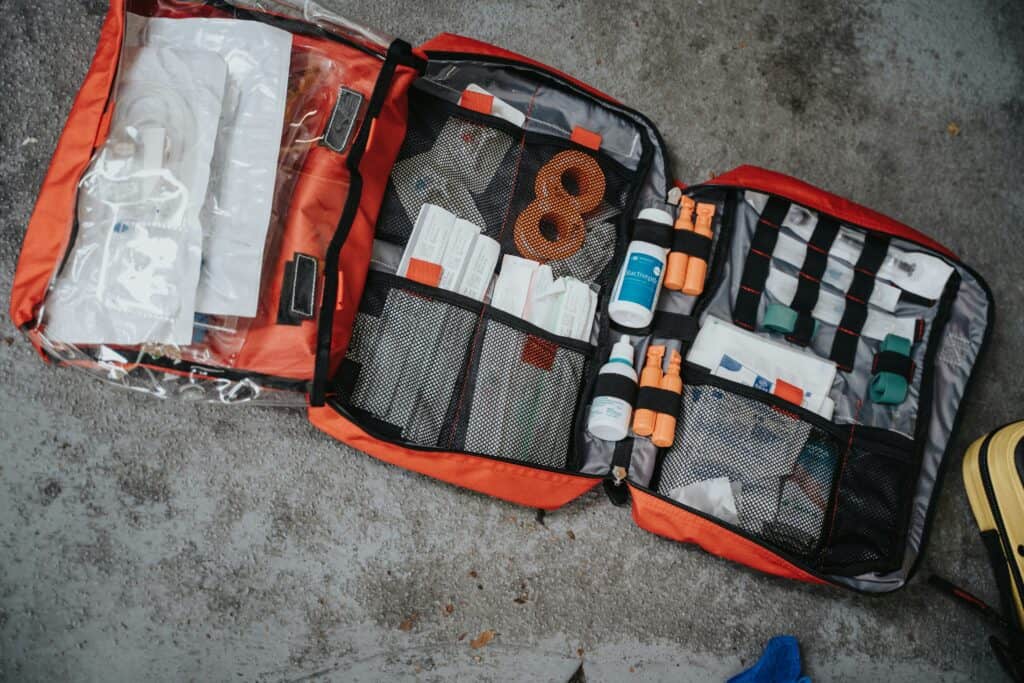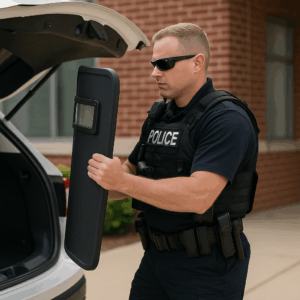Situational awareness plays a significant role in physical security, as it enables individuals to comprehend and process critical information about their surroundings. This aspect of human intelligence is essential for making informed decisions when responding to various threats and safety situations in any environment.
In the context of physical security, situational awareness is a continuous process that starts from the moment individuals wake up and become aware of their personal well-being. When arriving at a location, such as a school or workplace, individuals should be attentive to any irregularities or potential safety concerns. Within their environment, they must recognize points of concern, areas of refuge, and safe escape routes.
By fostering situational awareness, individuals can effectively act and adapt to changes in their environment and respond to potential threats, ensuring a higher level of physical security for themselves and others. Developing and maintaining situational awareness is, therefore, a crucial skill for those responsible for safeguarding people, property, and operations within any setting.
Situational Awareness and Its Importance
Situational awareness is a crucial aspect of ensuring physical security in various organizations, including schools, churches, and businesses. It involves the ability to identify, process, and comprehend critical information about the surrounding environment, ultimately leading to informed decision-making related to safety and security.
Situational awareness provides individuals with a heightened understanding of their surroundings, enabling them to assess the environment and identify potential advantages it offers. This includes recognizing favorable conditions, resources, or features that can be leveraged to enhance safety and security measures.
By being aware of their surroundings, individuals can also identify and address any limitations imposed by the environment. These limitations may include physical obstacles, restricted access points, or environmental factors that may impact security. By acknowledging and understanding these limitations, individuals can develop appropriate strategies to overcome them and ensure effective security measures.
For example, in a school setting, situational awareness can help identify potential advantages such as well-lit areas, natural surveillance points, or designated safe zones. Simultaneously, they can recognize limitations such as blind spots, areas with restricted visibility, or potential vulnerabilities in security infrastructure. This comprehensive understanding enables them to develop tailored security plans that capitalize on the advantages while mitigating the impact of limitations.
In a broader context, situational awareness empowers individuals in various settings, such as churches, businesses, or public spaces, to identify the specific advantages and limitations within their respective environments. This allows them to adapt security measures accordingly, making informed decisions to optimize safety and protect against potential threats.
By utilizing situational awareness to determine potential advantages and address limitations, individuals can enhance their ability to proactively respond to safety and security challenges, maximize the effectiveness of security strategies, and create a safer environment for themselves and others.
In the context of daily life, situational awareness is a continuous process that individuals should practice from the moment they wake up. For instance, teachers arriving at a school should be conscious of their surroundings, looking for signs of unusual activity or potential areas of concern. This constant vigilance extends to identifying safe spaces and routes within the school premises in case of emergencies.
Maintaining situational awareness is not restricted to personal observation alone. It can be enhanced through the use of various tools and technologies, radios, statistical data, video analytics, and CCTV systems. These tools contribute to a better understanding of the environment and consequently improve overall security.
In conclusion, situational awareness holds great importance in the context of physical security. It enables individuals and organizations to make informed decisions and take appropriate actions during challenging situations. Through continuous vigilance and effective use of available tools, situational awareness can be substantially improved, thereby ensuring a safer and more secure environment for all.
Components of Situational Awareness
Identifying Advantages and Limitations
Situational awareness is a crucial aspect of achieving success in physical security operations. It entails being conscious of one’s surroundings and understanding the implications of the current situation. Identifying potential advantages and limitations within the environment plays a significant role in this process. For instance, understanding the strengths and weaknesses of security measures or technological resources helps develop effective strategies to capitalize on available resources while overcoming obstacles.
Assessing Threats and Vulnerabilities
Another critical component of situational awareness in physical security is the ability to ascertain and assess various threats and vulnerabilities. This involves understanding the potential dangers and identifying areas where a security system or personnel might be at risk. Proper assessment of threats enables security professionals to avoid enemy strengths while exploiting critical vulnerabilities. Accurate evaluation and understanding of potential risks are vital for ensuring successful and efficient physical security operations.
Recommending Courses of Action
The final component of situational awareness is recommending appropriate courses of action based on gathered intelligence. This includes analyzing information about the environment, threats, and vulnerabilities within the context of organizational objectives. Security professionals must suggest suitable strategies and tactics that align with their organization’s goals while effectively addressing the identified risks and opportunities. Rapid decision-making and maintaining a high tempo in security operations are essential for achieving success in physical security situations.
Components of Situational Awareness and Their Application in Different Contexts
| Components | Schools | Churches | Businesses/Organizations | Individuals |
|---|---|---|---|---|
| Identifying Advantages and Limitations | Understanding the strengths and weaknesses of security measures and technological resources to develop effective strategies. | Recognizing the strengths and weaknesses of the church’s security infrastructure to optimize safety measures. | Identifying advantages offered by the organizational environment and leveraging available resources to enhance security. | Being aware of personal strengths and weaknesses to make informed decisions regarding personal safety. |
| Assessing Threats and Vulnerabilities | Ascertaining potential threats to student and staff safety and identifying areas where security systems or personnel may be at risk. | Assessing potential risks to the church community and identifying vulnerabilities that may impact security. | Evaluating various threats and vulnerabilities that can affect the organization’s operations, assets, and personnel. | Understanding potential dangers and identifying personal vulnerabilities to ensure personal safety and security. |
| Recommending Courses of Action | Analyzing gathered intelligence to recommend suitable security strategies and tactics aligned with the school’s objectives. | Formulating appropriate courses of action based on the identified threats and vulnerabilities within the church’s context. | Suggesting strategies and tactics that align with the organization’s goals while effectively addressing identified risks and opportunities. | Making informed decisions and taking appropriate actions based on the evaluated environment and potential risks. |
By applying these components of situational awareness, schools, churches, businesses/organizations, and individuals can enhance their ability to maintain a secure environment. It allows them to identify strengths and weaknesses, assess potential threats and vulnerabilities, and recommend suitable courses of action to mitigate risks effectively. This continuous evaluation and proactive approach contribute to overall safety and security in various settings.
Situational Awareness in Physical Security

Personal Well-Being
Situational awareness in the context of physical security begins with one’s personal well-being. It is essential to be conscious of one’s physical and mental state to ensure the ability to make effective decisions and stay aware of surrounding threats or anomalies. Maintaining a healthy lifestyle and managing stress are crucial aspects of personal well-being that contribute to better situational awareness.
Environmental Awareness
Being knowledgeable about the environment around you is another critical aspect of situational awareness in physical security. This involves identifying potential advantages and limitations imposed by the environment, such as natural barriers, visibility constraints, or areas of refuge. By understanding the layout of a particular environment, individuals and security teams can better assess potential risks and plan accordingly.
Recognizing Concerns
A crucial part of situational awareness is recognizing and assessing concerns in a given environment. This process may include identifying areas of potential danger, detecting unusual activities, or ascertaining the strengths and weaknesses of bad actors. By staying vigilant and actively assessing potential threats, one can better respond to potential security issues proactively and maintain a higher level of safety.
Safety Routes
Situational awareness in physical security also involves identifying and maintaining safe routes that can be utilized in case of emergency or threat. By being aware of various exit points, escape routes, or secure locations, individuals and security teams can make rapid decisions when needed. Planning and periodically rehearsing possible evacuation scenarios can significantly contribute to improved situational awareness.
In conclusion, situational awareness in physical safety and security is a continuous process, encompassing personal well-being, awareness of the surrounding environment, the ability to recognize potential concerns, and the knowledge of safety routes. By paying attention to these aspects, individuals and security teams can enhance their decision-making capabilities and create a safer environment.
Continuous Process Improvement
Situational awareness in physical security refers to an individual’s ability to identify, process, and comprehend critical elements of information about their environment and potential threats in real-time.
Continuous process improvement is a fundamental aspect of situational awareness. From the moment individuals wake up, they should be conscious of their personal status and surroundings. Upon arriving at a location, such as a school or workplace, they should be vigilant and identify any anomalies or potential hazards.
Being attentive to areas of potential concern, such as points of entry and potential hiding spots, is also crucial for maintaining situational awareness. As individuals navigate their respective environments, they should recognize the importance of identifying areas of refuge and determining routes of safety. In doing so, they continually enhance their ability to respond to unforeseen circumstances and efficiently make informed decisions.
Incorporating various elements of situational awareness enables individuals and organizations to achieve a higher degree of security. By staying alert and proactively analyzing the environment and potential threats, situational awareness acts as a valuable tool for maintaining physical security and promoting safety.
Frequently Asked Questions
What are the key principles for enhancing situational awareness in physical security?
Situational awareness is essential for maintaining physical security. Key principles for enhancing situational awareness include being conscious of one’s surroundings, identifying potential threats and vulnerabilities, and maintaining a proactive mindset. Staying informed and up-to-date on relevant information is also crucial for sustaining situational awareness.
How can situational awareness be applied in the context of school safety?
In the context of school safety, situational awareness involves being aware of one’s surroundings at all times. This includes recognizing irregularities in the environment, identifying potential threats, and planning for emergency scenarios. Teachers and staff should be vigilant in all areas of the campus, constantly assessing potential concerns and maintaining a thorough understanding of the school’s layout, escape routes, and refuge areas.
What is the role of intelligence in maintaining situational awareness?
Intelligence plays a pivotal role in maintaining situational awareness. It informs decision-making by providing essential information about the environment, potential threats, and identified vulnerabilities. Through intelligence gathering, individuals and teams are better equipped to make informed decisions and respond effectively to situations in real-time.
What is the connection between situational awareness and decision-making in high-stress environments?
Situational awareness is a critical component of decision-making in high-stress environments. It ensures individuals and teams remain knowledgeable about their surroundings and can effectively respond to rapidly changing circumstances. With a keen understanding of the situation at hand, informed decisions can be made to maintain safety and security.
How can situational awareness be used to identify potential threats and vulnerabilities?
Situational awareness enables individuals to recognize potential hazards within their environments. By actively observing and analyzing one’s surroundings, threats and vulnerabilities become easier to identify. This information can then be used to inform planning, determine appropriate courses of action, and address identified security concerns.
What are effective strategies for incorporating situational awareness into daily routines and practices?
Incorporating situational awareness into daily routines and practices can involve consistent observation, assessment, and application of gathered information. Regularly reviewing and updating emergency plans, participating in training exercises, and maintaining open lines of communication with colleagues and security teams are also essential for sustaining situational awareness and ensuring optimal readiness in the face of potential threats.








